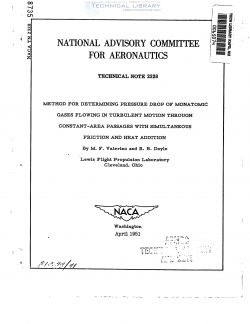naca-tn-2328
- Version
- 151 Downloads
- 3.32 MB File Size
- 1 File Count
- December 14, 2016 Create Date
- December 14, 2016 Last Updated
National Advisory Committee for Aeronautics, Technical Notes - Method for Determining Pressure Drop of Monotomic Gases Flowing in Turbulent Motion Through Constant Area Passages with Simultaneous Friction and Heat Addition

Charts are presented that enable convenient determination of the
pressure drop sustained by'm'onatomic gases (ratio of specific heats,
5/5) flowing at high subsonic speeds in a constant-area passage under
the simultaneous influence of friction and heat addition. '
Although the charts are constructed for determining pressure
drops when heat is added at constant passage-wall temperature, pres-
sure drops can be determined with good accuracy for other modes of
heat addition through the use of an effective wall temperature in
conjunction with these charts.
The effective wall temperature is given in terms of the passage
dimensions, gas-flow conditions, and gas-temperature rise across the
flow passage. The gas-temperature rise is related to the maximum
passage-wall temperature for the cases of heat addition at constant
wall temperature, constant rate of heat input along the passage length,.
and sine variation of heat input along the passage length.
Many problems arise in aircraft heat—exchanger practice that
involve the transfer of heat at high flux rates to a compressible
fluid flowing at high speeds through constant-area flow passages.
For example, in some recent heat-exchanger designs, the temperature
differential between heat-exchanger wall and fluid approached values
of the order of 12000 R and the fluid velocities approached the choke
condition (Mach number, 1).
Methods have been developed for determining the pressure drop
experienced in the passage of air through the radiator tubes of
reciprocating engines (references 1 and 2). These methods contain
simplifying assunptions that, although adequate over the range of
conditions encountered. in aircraft radiators, cause appreciable error
at the high airspeeds and heat-input rates considered herein.
In reference 5, the basic differential flow equation describing
the pressure variations of a compressible fluid under the simultaneous
action of friction and heat addition is numerically integrated for the
specific case of air heated at constant passage-wall-temperature con-
ditions. A closed-form solution of the basic differential flow equation
is obtained in reference 4 for the special case of an exponential vari-
ation of fluid temperature with distance along the flow passage. In
reference 5, the basic differential flow equation is formally integrated
by use of a simplification that is shown to introduce little error in
the description of the flow process; the integration results are pre-
sented for air in convenient chart form and are applicable for arbitrary
heat-input distribution to the fluid along the flow passage.
| File | Action |
|---|---|
| naca-tn-2328 Method for Determining Pressure Drop of Monotomic Gases Flowing in Turbulent Motion Through Constant Area Passages with.pdf | Download |

Comment On This Post